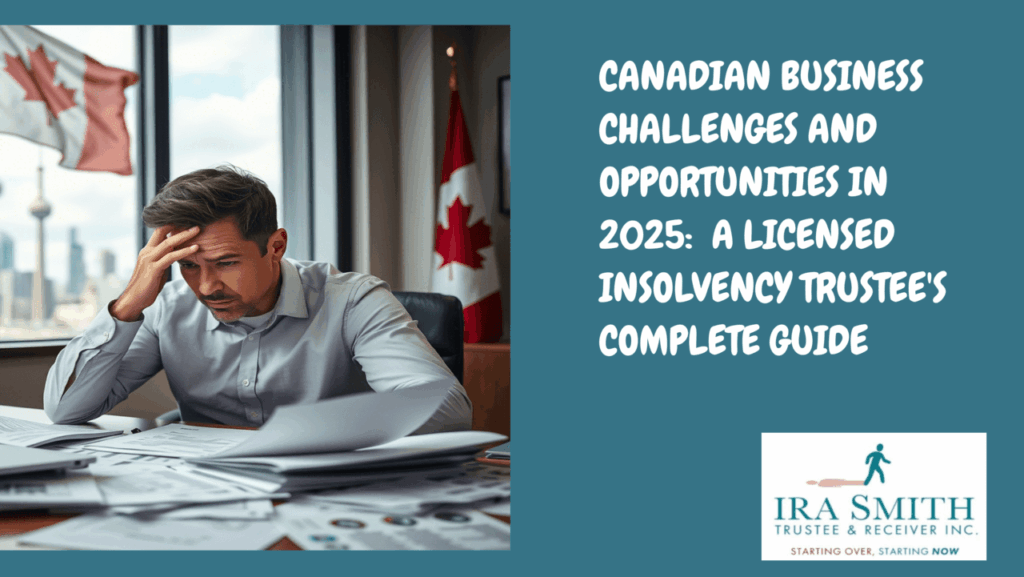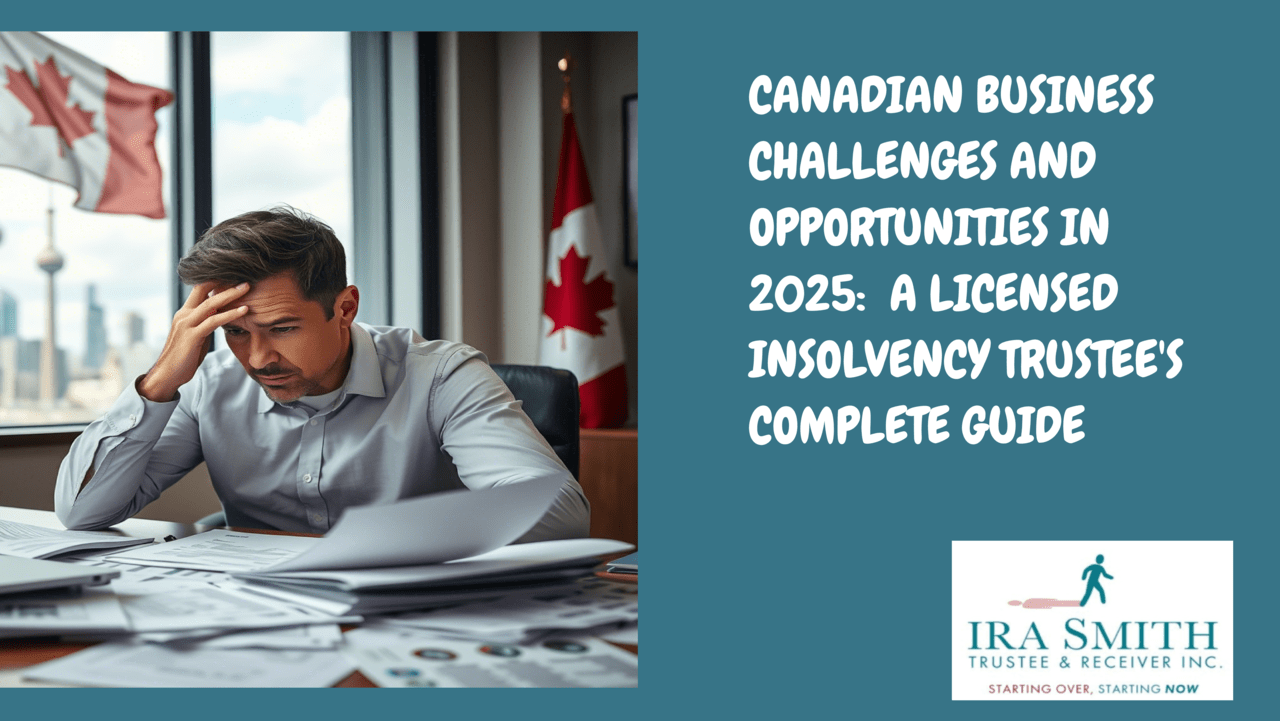Canadian Businesses Introduction
As a Licensed Insolvency Trustee firm serving the Greater Toronto Area for over 20 years, we’ve seen Canadian businesses go through many ups and downs. Right now, we’re facing some tough times that remind me of the beginning of the 2008-2009 financial crisis. But there’s more to the story than just bad news.
Let me share what I’m seeing on the ground and what it means for owners of Canadian businesses like yours.
Overview of the Canadian Business Environment
The Canadian business landscape in 2025 is complex. While some large corporations are doing well, many small and medium Canadian businesses are struggling. This creates a two-speed economy depending on company size, which affects different sectors in different ways.
Current Economic Indicators
Recent data from Statistics Canada shows mixed signals for Canadian businesses:
- Corporate profits rose by $4.2 billion in Q1 2025
- The Canadian Small Business Health Index dropped to 99.3
- Canadian businesses’ delinquencies are at their highest since 2009
- Credit demand from businesses has slowed significantly
These numbers tell us that while big companies might be profitable, smaller Canadian businesses are having a harder time. This gap is important because small businesses employ millions of Canadians and drive local economies.
Regional Differences Across Canada
Not all provinces are experiencing the same challenges. Ontario and British Columbia are seeing the biggest increases in Canadian businesses‘ financial stress:
- Ontario business arrears have jumped by 19%
- British Columbia business debt has risen by 20%
- The Prairie provinces and Atlantic Canada are facing their unique challenges
These regional differences matter because they show how national policies and global events affect different areas of Canada in unique ways.
Key Economic Drivers
Several factors are shaping the Canadian business environment:
Energy Sector Impact: Canada’s energy sector continues to influence the overall economy, though renewable energy investments are growing.
Technology Adoption: Canadian businesses that adapted to digital tools during COVID-19 are generally performing better than those that didn’t.
Supply Chain Resilience: Companies with diversified supply chains are handling current challenges better than those dependent on single sources.
Challenges in the Canadian Business Landscape
Canadian businesses face several major challenges right now. Understanding these helps explain why so many companies are struggling with their finances.
Rising Business Delinquencies
The numbers are concerning. Canadian businesses’ delinquencies have reached levels not seen since the 2009 financial crisis. This means more companies are falling behind on their payments to suppliers, landlords, and lenders.
What does this mean for you as a business owner?
- Cash flow problems become more common
- It’s harder to get credit when you need it
- Suppliers may demand payment up front
- Your customers might pay you later (or not at all)
Impact of Trade Tensions
The ongoing trade dispute with the United States is hitting our interconnected trade relationship with the USA and, therefore, Canadian businesses hard. When politicians in Washington announce new tariffs or trade policies requiring a new agreement on trade, it affects your business here in Canada.
Here’s how trade tensions hurt Canadian business:
Supply Chain Disruptions: Products you need might be delayed or cost more. One business owner told me, “I never thought a tweet could shut down my supplies.”
Increased Costs: Tariffs make imported goods more expensive, which squeezes your profit margins.
Uncertainty: It’s hard to plan for the future when trade rules keep changing.
Customer Impact: Higher costs often mean higher prices, which can drive away customers.
Credit Market Tightening
Banks and other lenders are being more careful about who they lend money to. This creates a problem for Canadian businesses that need financing to grow or even survive.
Signs of credit tightening include:
- Longer approval times for business loans
- Higher interest rates
- More paperwork and requirements
- Smaller loan amounts are being approved
Regulatory and Tax Pressures
Many business owners feel overwhelmed by government regulations and taxes. While some rules protect workers and consumers, they can also make it harder to run profitable Canadian businesses.
Common regulatory challenges include:
- Complex tax requirements
- Employment standards compliance
- Environmental regulations
- Industry-specific rules and licensing
Lingering Effects of COVID-19
The pandemic changed how we do business, and some of those changes are still causing problems. Many Canadian businesses are still dealing with:
- Higher operating costs
- Changed customer behaviours
- Staffing shortages
- Debt taken on during lockdowns
Opportunities for Canadian Business Growth Strategies and Expansion
Despite the challenges, there are real opportunities for Canadian businesses that position themselves correctly. Smart business owners who are innovative leaders are finding ways to succeed even in tough times.
Digital Transformation Advantages
Canadian businesses that embrace technology are often doing better than those that don’t. The pandemic forced many companies to go digital, and those that did it well are seeing benefits.
Digital opportunities include:
E-commerce Growth: Online sales continue to grow, even as physical stores struggle.
Remote Work Benefits: Companies can hire talent from anywhere and reduce office costs.
Automation Savings: Technology can reduce labour costs and improve efficiency.
Better Customer Data: Digital tools help you understand your customers better.
Market Consolidation Opportunities
When times are tough, weaker competitors often exit the market. This creates opportunities for stronger Canadian businesses to:
- Acquire competitors at lower prices
- Hire experienced employees from failing companies
- Take over market share from Canadian businesses that close
- Negotiate better deals with suppliers
Government Support Programs
Various levels of government offer support programs for Canadian businesses. These can provide crucial help during difficult times:
Federal Programs:
- Canada Emergency Business Account (CEBA) extension
- Export development funding
- Innovation grants and tax credits
Provincial Programs:
- Ontario Small Business Support Grant
- British Columbia Recovery Grant programs
- Industry-specific support initiatives
Municipal Programs:
- Property tax deferrals
- Local development incentives
- Small business support funds
Sector-Specific Growth Areas
Some industries are growing despite overall economic challenges:
Healthcare and Senior Services: Canada’s aging population creates opportunities in healthcare, home care, and senior services.
Green Technology: Government commitments to climate goals mean funding and opportunities for clean technology businesses.
Professional Services: As Canadian businesses face complex challenges, there’s a growing demand for legal, accounting, and consulting services.
Essential Services: Canadian businesses that provide necessities often remain stable during economic downturns.
When Canadian Business Financial Challenges Become Too Much
Sometimes, despite best efforts, Canadian businesses face financial problems that seem impossible to solve. This is where my expertise as a Licensed Insolvency Trustee becomes valuable.
Warning Signs to Watch For
If your business shows these signs, it’s time to get professional help:
- Consistently late on payments to suppliers
- Difficulty making payroll
- Maxed out credit lines
- Receiving demand letters or legal notices
- Customers are complaining about delayed orders
- Losing key employees due to unpaid wages
How Professional Help Can Make a Difference
As a Licensed Insolvency Trustee, I help Canadian businesses and their owners navigate financial difficulties. My services include:
Business Restructuring: Sometimes, a business can be saved with the right restructuring plan. This might involve negotiating with creditors, reorganizing operations, or finding new financing.
Asset Sales: If a business can’t continue, I can help maximize the value of its assets through organized sales processes.
Personal Insolvency Solutions: When business debts affect personal finances, I provide options like consumer proposals or personal bankruptcy to give owners a fresh start.
Creditor Negotiations: I work with creditors to find solutions that work for everyone involved.
Advisory Services: I provide actionable advice to develop a roadmap for you to follow, where there is a way for company management to carry out a self-help restructuring without resorting to a formal insolvency process.
The Importance of Acting Early
The earlier you seek help, the more options you have. Many business owners wait too long, thinking things will improve on their own. While optimism is important, it’s also crucial to be realistic about your situation.
Early intervention can:
- Preserve more of your business value
- Protect your personal assets
- Maintain relationships with key employees and customers
- Provide more restructuring options
Looking Forward: What Canadian Business Owners Should Do
The current environment is challenging, but it’s not hopeless. Here’s my advice for Canadian business owners:
Focus on Cash Flow Management
Cash flow is the lifeblood of Canadian businesses. In tough times, it becomes even more critical:
- Monitor your cash flow weekly, not monthly
- Speed up collections from customers
- Negotiate better payment terms with suppliers
- Keep detailed records of all financial transactions
Build Strong Professional Relationships
Having the right advisors can make all the difference:
- Work with an experienced accountant
- Maintain relationships with multiple lenders
- Know when to consult with legal counsel to solve pressing legal issues
- Have a Licensed Insolvency Trustee you can call if needed
Stay Informed and Adaptable
The business environment is changing rapidly. Stay informed about:
- Government service support programs
- Industry trends and opportunities
- Regulatory changes that affect your business
- Economic indicators that impact your sector
Plan for Multiple Scenarios
Don’t just plan for success – plan for different possibilities:
- Best case: How will you handle rapid growth?
- Worst case: What will you do if revenue drops significantly?
- Most likely case: What’s your realistic path forward?

Canadian Businesses Conclusion
The Canadian business environment in 2025 presents both significant challenges and real opportunities. While business delinquencies are rising and credit markets are tightening, there are still paths to success for well-managed companies.
The key is to stay informed, act decisively, and seek professional help when needed. Whether you’re looking to grow your business or navigate financial difficulties, having the right support makes all the difference.
As someone who has helped many Canadian businesses and business owners, I’ve seen companies survive and thrive even in the toughest times. The businesses that succeed are those that face reality honestly, adapt quickly, and aren’t afraid to ask for help when they need it.
If your business is facing financial challenges, don’t wait until it’s too late. Early intervention provides more options and better outcomes. Contact Ira Smith Trustee & Receiver Inc. today to discuss your situation confidentially and explore your options.
You’re not alone in this. There’s a path forward, and it starts with reaching out for the right kind of help. Take that step—you deserve it. If you’re a GTA resident dealing with overwhelming debt, don’t wait for your credit situation to get worse. As a licensed insolvency trustee serving Toronto, Mississauga, Brampton, Markham, and surrounding areas, I’m here to help you understand your options.
Free consultation available:
- No obligation to proceed
- Complete review of your Canadian business debt and credit situation
- Practical next steps you can take immediately
Remember: Your current financial situation doesn’t define your future. With the right help and information, you can overcome both debt challenges and credit score problems.
As a licensed insolvency trustee serving the Greater Toronto Area, I encourage consumers and business owners to view financial difficulties not as failures but as challenges that can be addressed with proper guidance. By understanding the warning signs of insolvency and seeking professional advice early, many people and businesses can find a path forward – whether through restructuring, strategic changes, or in some cases, an orderly wind-down that protects their future opportunities.
Remember: The earlier you seek help for company insolvency concerns, the more options you’ll have.
If you or someone you know is struggling with too much debt, remember that the financial restructuring process, while complex, offers viable solutions with the right guidance. As a licensed insolvency trustee serving the Greater Toronto Area, I help Canadian entrepreneurs with understand their options and find a path forward during financial challenges.
At the Ira Smith Team, we understand the financial and emotional components of debt struggles. We’ve seen how traditional approaches often fall short in today’s economic environment, so we focus on modern debt relief options that can help you avoid bankruptcy while still achieving financial freedom.
The stress of financial challenges can be overwhelming. We take the time to understand your unique situation and develop customized strategies that address both your financial needs and emotional well-being. There’s no “one-size-fits-all” approach here—your financial solution should be as unique as the challenges you’re facing.
If any of this sounds familiar and you’re serious about finding a solution, reach out to the Ira Smith Trustee & Receiver Inc. team today for a free consultation. We’re committed to helping you or your Canadian company get back on the road to healthy, stress-free operations and recover from financial difficulties. Starting Over, Starting Now.
The information provided in this blog is intended for educational purposes only. It is not intended to constitute legal, financial, or professional advice. Readers are encouraged to seek professional advice regarding their specific situations. The content should not be relied upon as a substitute for professional guidance or consultation. The author, Ira Smith Trustee & Receiver Inc., and any contributors do not assume any liability for any loss or damage.






